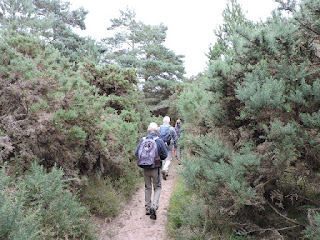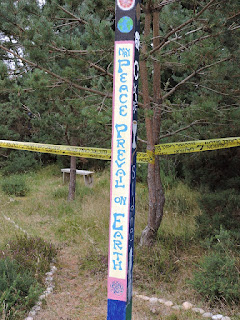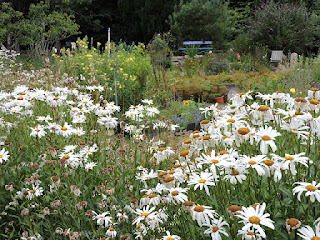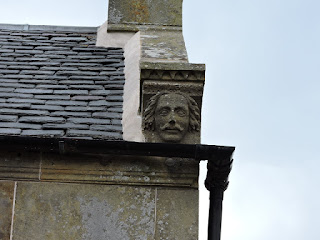FINDHORN
Dave and Sandra decided to take us to find the horn for the August walk. We all met up at the car park by the beach and the toilet block. We nearly did an Agnes, arriving just in time after a degree of confusion over where, exactly, the car park was. Suffice to say, Agnes' record remains unsullied and we got there in time to see Robin busking and Liz getting a few pennies out of her purse. Sandra was pretending to play the accordion to accompany Robin's dancing.
Soon enough we were on our way round the bay and heading to the beach.
This gave us gave us the opportunity to look over to the other side of the water and fondly remember when the tide came in and soaked those of us on a different walk, in a different time.
It wasn't a happy memory for some of the party. Happily, I was not there and felt no frisson of terror or cold, wet boots and feet.
Besides, it looks like the Caribbean to me.
I assume the windsock is there to help the many sailors who use this part of the coast. Certainly, there aren't many planes landing on the dunes or the shingle. Windsocks are sometimes called cones. They are ancient and were thought to have first been used by the Japanese and originally were erected outside houses to signify the birth of a child, usually a boy. This one shows that there wasn't a lot of wind about. If the wind gets up to 17 miles per hour, the sock would be flying horizontally - yes these things are not just bits of cloth, they are actually calibrated. They orientate themselves according to the direction of the wind. Just to be clear, the bigger end faces into the wind.
We split up a bit at this point, with some, you might say the lower class, walking on the beach. Others, some might say, the upper class, walked along the top of the dunes.
From the top of the dunes, one could look down on the lower, beach walkers.
Of course, it wouldn't be a beach without beach huts.
These beach huts are, apparently very strongly built. No doubt, that explains the cost of £25000. For something that is more colourful than, but smaller than, a prison cell!
Of course, you don't get a view like this from a cell and it is up to you when you pay a visit. I'm not sure what the slopping out arrangements are, though.
There was a further split as Dave and Hugh, decided to join a different lower class.
Even had Sharon and I wanted to join the first, lower class, the way down was barred to us. Or, was it designed to prevent the lower class climbing up to the top.
Something was attracting the gulls out in the bay. I could not tell what it was, but a few days later it seems that a number of dolphins had stranded and died in the wider Moray Firth area and then some had also died after refloating, including one in Findhorn Bay. Whether that is what was attracting the birds, I don't know, but it may have been.
The lower group, were approaching the point where they would have to rejoin the upper group.
Luckily the way was pointed out to them.
That way turned out to be across the lunar landscape behind the face of the dunes.
There was a discernible pathway, probably left by American astronauts as they pretended to be on the real moon all those years ago. Of course, the trees have grown since then!
Giant steps were what we took, walking on the moon.
We headed into the scrub trees on the dunes, before we started inland towards the Findhorn Foundation.
Summer is coming to an end as a bit of autumn fruitfulness made clear.
A bit of wind horsepower.
There were other berries about. I didn't recognise these, but after a bit of research, I'm pretty confident it is a Guelder Rose. These are not roses, but a type of Viburnum and they are relatively uncommon in Scotland. They often indicate older woodlands, but I suspect these may have been planted as they are very good for birds and wildlife. You can make jam out of the berries, but they are mildly toxic if eaten raw.
We were getting close to the Foundation.
This was the entrance to their woodland garden, but we did not go in.
Although, the entrance was quite inviting.
This was the older part of the Foundation site and there were a few of these hobbit like dwellings about.
The Findhorn Foundation is a strange, intriguing, interesting and oddly spiritual place, even for an old cynic like me.
It has an odd history.
It was founded, accidentally, in 1962. How so, you might ask. Well, it appears that Peter and Eileen Caddy and Dorothy MacLean had come to Forres in 1957 and ran the Cluny Hill hotel there along spiritual ;lines. They parted company with the owners in 1962 and all three moved with Peter and Eileen's three sons to the caravan site at Findhorn.
They had little money and Peter started to grow vegetables to make ends meet. Eileen, who meditated, discovered that she could contact the intelligence of plants and then she was given the secret of how to make the most of the garden. Peter followed the guidance, with remarkable results, including 40 pound cabbages! Stop laughing, Hugh!
The fame of the garden grew and soon attracted numbers of like minded people to follow a spiritual path to live in harmony with nature. The community continues to grow and expand in accordance with these early ideas and beliefs. The Foundation is a registered charity and it operates throughout the world, having first expanded from the caravan park to buy the Cluny Hill hotel in Forres and then to set up retreats in Iona and nearby.
Not your average scheme, then.
Not your average library, either.
I doubt this is your average dance performance and, at our age, a marathon of intimacies sounds like a bit much of an undertaking.
It is not all sweetness and light at the Foundation. This vacant site, with a single charred pole, is all that is left of the community centre after a disgruntled employee burnt it down not too long ago. I would expect that the Foundation will want to build it back better, to borrow a phrase from somebody or other.
Time to stop for lunch.
Pam couldn't get the sandwiches down quick enough.
Maureen was much the same.
A bit more decorum here.
We were being watched by a magpie. No chance of crumbs from Pam, I suspect.
As you might expect, they're pretty keen on composting and recycling here.
They even grow veg on the compost bins.
New eco houses continue to be built, suggesting that there is ongoing interest in this particular way of living.
Who could deny the sentiments which seem to abound here, even if it is a bit Miss World of old to wish for World Peace. Frankly, I think we need it more now than ever before.
We left the Foundation as most people would know it and went into Cullerne gardens. They are actually part of the Foundation, although the house seems, currently, to be for sale. The gardens are a horticultural training area, where flowers and vegetables are grown for the community. You can sign up to help for a week in the spring. slightly oddly, you are invited to "attune" to a price of between £390 and £170 for this and it covers your accommodation, full board and refreshments.
The house, itself is not listed and I can't find out much about it except that it is Victorian and you could buy it for £720000. It seems to have some private gardens, but the more public gardens, whilst a bit deliberately unkempt, have a couple of very nice ponds.
Lots of big polytunnels, full of produce.
There are quite informal cottage garden planting areas.
Some Zen places to sit.
Another flower, I didn't recognise. It turns out to be an Oenothera, which is the same species as the Evening Primrose. However, this one is Oenothera odorata, which is native to South America and the yellow flowers turn red after time.
Even more amazing than changing colour is the ability of these types of plants to hear. Yes, hear! Apparently, someone discovered that when the vibration of bee wings was detected by the petals, the concentration of nectar in the plant increased markedly. They then cut the petals off and this effect did not happen, showing that the petals were acting as the ears of the plant. Amazing.
Another peaceful pond.
A fine specimen of Picea Breweriana - Brewer's Spruce. This is a very rare tree in the wild, being found only on a few mountain tops on the Oregon - California border. It has been widely planted in the UK in the past, but tall specimens are rare. The spectacular weeping foliage is thought to be an adaptation to allow heavy snow to be shed from the branches. It was discovered by Professor William Henry Brewer in 1863.
Apparently, the drooping foliage can extend to 2 metres.
You can see Hugh reflecting deeply on all of that interesting tree information.
The rear of Cullerne House - the front faces attractive gardens that we did not see. I suspect one of the reasons it is not listed is because of the fairly execrable box extension nearest to us.
After leaving the gardens, we walked along the front back towards the village of Findhorn, which means white water in Gaelic and probably derives from the river Findhorn, at the mouth of which, the village sits.
As some might expect, there are a few potheads hereabouts.
There were some other heads about.
Flower heads, too.
Presumably a nice warm chimney head.
I expect something also stood on this little platform on the corner of this house, but I can find no reference to it.
Almost back where we started and time for a cup of tea and a cake.
Here we are enjoying our well earned rewards.
Thanks are due to Dave and Sandra for organising the walk, the weather and actually getting us a table in the café given how full the village was.































































